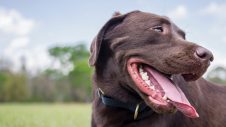To help you identify the ‘good gunk’ from the ‘bad gunk’, Dr. Chris Blair from Greencross Vets Faulconbridge has the following tips:
Good gunk
‘Normal eye gunk is like a vacuum cleaner canister getting filled up with dust,’ Dr. Blair says. ‘Special mucous cells in the eye collect dust, pollen, and particles, and the end result is a slimy grey accumulation of gunk building up in the eyes.’
Dr. Blair says it’s important to regularly clean up the gunk around your dog’s eye with a moistened tissue.
‘If the good gunk is not cleaned, then it will accumulate and stain the hair around the eye,’ he says. ‘If the grey gunk builds up at a greater than normal rate, look for issues causing the problem. For example, your dog riding in the back of the ute.’
If you can’t identify the issue, visit your local Greencross Vets for advice.
Bad gunk
Dr Blair says you can easily identify bad gunk because it is usually yellow or green, in long rope strands.
“Sometimes the eyelids are stuck together. This needs urgent attention from your vet,” he says. “If your dog has chronic grey gunk, then ask your vet for soothing eye drops.
“Tear production is also checked, as a lack of tears is a common problem with junk accumulation.”
On the other hand, some pets have a blocked tear duct, resulting in tears overflowing.
“This shows up as a brown stain on the fur under the eye. See your vet about this problem,” says Dr Blair.
Visiting your vet
If gunk build up has led to your dog suddenly getting a red eye you should see your local Greencross Vets without delay as it may be a sign of an acute infection, or glaucoma.
Conversely, you should not clean up the bad gunk. Instead, take your pet straight to the vet so that they can assess the situation.
“If bad gunk is allowed to accumulate, then permanent eye damage may result,” he says.
“Skin will heal easily, but the eye is a very specialised organ and has poor powers of healing, so prompt attention and treatment is the key to keeping the eyes healthy.”

 Greencross Vets
Greencross Vets 


